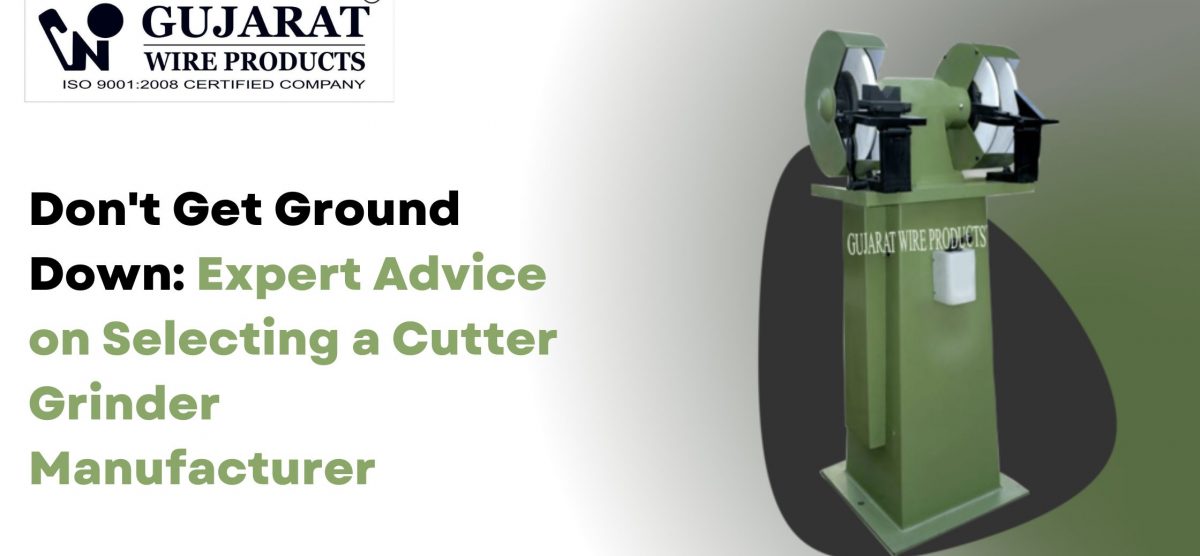Blog

Don’t Get Ground Down: Expert Advice on Selecting a Cutter Grinder Manufacturer
Choosing the right cutter grinder manufacturer can feel challenging. And you are not alone with this. The market is filled with slow setups, poor service, and spiraling consumable costs. After working with shops that live and die by geometry, finish, and uptime, I’ve seen firsthand what separates a solid grinder partner from a costly mistake.
In this guide, you’ll learn a practical, ground-level way to shortlist and select the right cutter grinder: how to define your use-case, choose between manual and CNC, test the four accuracy fundamentals, evaluate workholding and consumables, weigh software and automation, check facility fit, calculate total cost of ownership, and finally, run an acceptance test that turns promises into proof.
Define your use-case first — why this matters
You’ll learn how to translate your parts and volumes into machine requirements.
Before you touch brochures, write four lines on one page:
- Tool family: End mills, drills, reamers, form tools, nail cutters—list the top 5 SKUs by volume.
- Material: Carbide vs HSS drives wheel choice (diamond vs CBN) and spindle behavior.
- Targets: Diameter/runout limits, land/relief geometry, surface finish (Ra), edge radius. Use actual numbers.
- Volume & mix: Daily pieces, changeovers/week, any lights-out goals.
These four lines control everything that follows. If you can’t state them cleanly, you can’t evaluate cleanly.
Pick the machine class — universal/manual vs CNC
You’ll learn when manual wins and when CNC pays for itself.
Manual/Universal
- Best for: Low volume, high mix, experienced operators, one-off regrinds.
- Strengths: Low capex, tactile control, fast for simple jobs.
- Trade-offs: Skill-dependent repeatability; slower changeovers; limited automation.
CNC (4/5-axis)
- Best for: Complex geometry, strict tolerances, repeat batches, reduced operator dependency.
- Strengths: Libraries, simulation, consistent results, probing, wheel packs, loaders.
- Trade-offs: Higher capex; training curve; software discipline required.
Rule of thumb: If your acceptance criteria are strict and you care about cycle time, CNC wins. If you live on variety with artisan operators, a stout universal grinder can be perfect.
Check the four fundamentals — accuracy lives here
You’ll learn what to ask for (and measure) on the demo floor.
- Rigidity & damping: Base/column design, mass, ribbing. Chatter kills finish; flex ruins geometry.
- Spindle quality: Runout at taper, power/torque under load, thermal control. Carbide needs honest RPM under pressure.
- Axes & feedback: Ballscrews/linear guides, encoder class, backlash compensation. Repeatability should be shown, not promised.
- Thermal stability: Warm-up behavior and drift over a shift. Accuracy at 10 a.m. must match 4 p.m.
Ask for live indicators and real cuts on your geometry. If the vendor avoids measurements, you have your answer.
Prioritize workholding — where precision is won or lost
You’ll learn how fixtures decide repeatability and changeover time.
- Collets & air bearings: Verify system TIR with your shanks. Don’t accept catalogue values—measure.
- Indexing/radius fixtures: Reduce “hand feel.” Fixtures that lock geometry beat human guesswork.
- Modularity: Map your top 3 setups. How many minutes from Tool A to Tool B, door-to-door?
- Spare sets: India reality: a second fixture set often pays back in a month by killing queue time.
If a manufacturer hand-waves fixtures, expect to pay with scrap and overtime later.
Specify wheels, bonds, dressing, and coolant — your real cutting edge
You’ll learn how consumables define finish, cycle time, and cost/part.
- Wheel choice: Diamond for carbide; CBN for HSS. Deviate only with a reason.
- Bonds: Resin (cool, forgiving) vs metal/hybrid (longer life, hotter). Match to geometry and finish.
- Dressing/truing: Put dress parameters in writing for each tool family. Fresh wheel = stable process.
- Coolant & filtration: Flow, concentration, temperature control, and cleanliness. Dirty coolant is a blunt tool in liquid form.
Ask the OEM to propose a wheel + dress + coolant “recipe card” for your top tools. Make it part of the acceptance record.
Evaluate software & ecosystem — the productivity multiplier
You’ll learn how the UI, libraries, and integrations affect daily output.
- Libraries/templates: Can you model your tools quickly? Are there parametric forms for your geometry?
- Simulation/collision: Offline programming avoids expensive collisions and setup roulette.
- Openness: Probing, in-process measurement, post-processing, and metrology exports should play nicely with your stack.
- Learning curve: How long until a competent machinist ships good parts? Ask for a training plan, not a pep talk.
- Versioning: Who owns updates? What’s the policy on bug fixes and license moves?
If software looks clever but your team can’t learn it in weeks, it’s a museum piece.
Right-size automation & in-process control — consistency without drama
You’ll learn which add-ons actually move the needle in India-first conditions.
- Wheel packs/changers: Big win for multi-step geometry and fewer manual swaps.
- Loaders: Even basic loading stabilizes takt time and frees operators for higher-value work.
- Probing/in-process metrology: Closed-loop corrections keep you inside spec as wheels wear.
- Phased upgrades: Start with probing + wheel pack; add robots once volumes justify it.
Trend in Indian shops: modest automation beats “all or nothing.” Buy reliability first, robots second.
Fit to your facility — avoid hidden deal-breakers
You’ll learn quick checks that prevent infra surprises post-purchase.
- Footprint & weight: Confirm floor load and service clearances.
- Power/air: Match phase, amps, and air quality; plan for voltage stability (common pain point).
- Coolant/mist: Where does it live? How is it serviced? Extraction matters for health and finish.
- Ergonomics & safety: Sightlines, reach, guarding, interlocks. Setup should feel safe without gymnastics.
- Environment: AC or not? If ambient swings, thermal drift will follow. Plan controls, not prayers.
Document these in a pre-install checklist. It saves you weeks.
Service, training, parts, and TCO — the ROI you don’t see on day one
You’ll learn how to price the “whole ownership,” not just the machine.
- Service SLAs: Who answers, how fast, what’s the escalation ladder? Remote diagnostics should be real.
- Training: Initial + refresher. Operator turnover happens—plan for it.
- Spares lead times: A ₹4,000 sensor with a 3-week wait costs lakhs in downtime.
- Warranty clarity: Scope, exclusions, and response obligations in writing.
- TCO model (36 months): Machine + fixtures + wheels/consumables + coolant/energy + maintenance + software/training + downtime risk.
India-first tip: stock a small “red bin” of fast-moving spares. It’s cheap insurance against courier delays and festival calendars.
Prove it before you buy — your acceptance plan
You’ll learn a one-page test that turns promises into proof.
Bring your parts. Define pass/fail. Measure together.
- Geometry: Diameter, runout, rake/relief, land width, edge prep.
- Finish: Ra on the relevant surfaces; agree on the gauge and method.
- Cycle time: Real cut, not brochure time.
- Changeover: Tool A → Tool B, door-to-door minutes.
- Repeatability: Make 5; measure 5. No cherry-picking.
- Recipe cards: Lock wheel, dress, coolant, and program versions for your top tools.
- Training handoff: Operators must run the second piece with only SOPs, not hand-holding.
If the machine hits your acceptance now, it will be in production. If it doesn’t, keep your capex.
Next Steps — one practical jump-off
Within a week, you can turn this post into action: write a four-line brief covering tools, material, targets, and volume/mix; shortlist three vendors that fit your class (manual or CNC); schedule a demo using your parts and the acceptance plan; capture results on a one-page scorecard measuring geometry, finish, cycle, changeover, and repeatability; and base your choice on proof, not pitch—benchmarking fundamentals and service expectations against Gujarat Wire Products’ published grinder details, then holding every vendor to the same test run; if this helps, share it with your team and let me know where your acceptance plan feels stuck so I can help you tighten it.
FAQs — quick answers to high-intent questions
Q1: How do I compare two similar-spec CNC grinders?
A: Use the acceptance run. Same tools, same wheel recipe, same coolant, same gauges, same operator skill. The faster, more repeatable result wins. Paper specs don’t cut metal.
Q2: Is a manual grinder still relevant if I plan to scale?
A: Yes, as a flexible toolroom asset for odd jobs and emergency regrinds. But for scale and uniformity, budget CNC for your top SKUs.
Q3: What’s the fastest way to lower cost/part without a new machine?
A: Often: better fixtures, a disciplined dressing routine, and a cleaned-up coolant circuit. Many shops leave easy wins on the table.
Q4: Do I need a robot from day one?
A: Usually not. Start with wheel packs and probing. Add a loader once your mix stabilizes and the math proves it.
